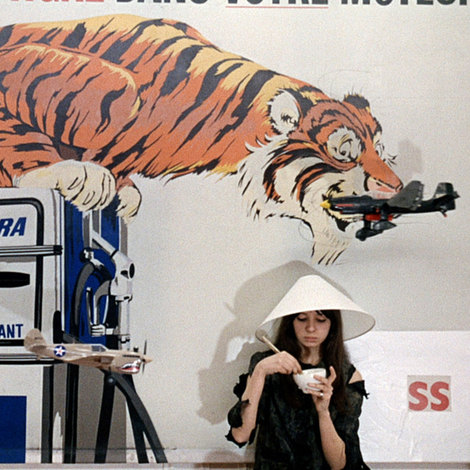With more than two million visitors a year, second only to Disneyland Paris, Puy du Fou is the most popular French amusement park you’ve never heard of. Tucked into a verdant corner of the Vendée region, southwest of the Loire Valley, it’s as if Colonial Williamsburg were reimagined by Up with People, but with better taste and far more questionable politics. A deeply nationalistic, ostensibly historic entertainment spectacle, this summer it became a perfect storm of pandemic crisis, the stirrings of a French culture war, and accusations of presidential favoritism toward its large-headed founder, Philippe de Villiers.
“A nation is a bond of love,” de Villiers wrote in Les Gaulois Réfractaires Demandent des Comptes au Nouveau Monde (The Unbreakable Gauls Hold the New World to Account), his diatribe against globalism and France’s pandemic response which came out this June. “France is a romance novel.”
Clinging to Tradition
De Villiers, a right-wing aristocrat from the Vendée, started ripping bodices in 1977, when he decided to put on a show. Before he became a local political boss active in a movement to restore the French monarchy, served as a member of the European Parliament on a nationalist ticket (irony alert), was secretary of state for culture under Jacques Chirac, and twice ran for president, he earned his political chops by convincing 600 or so of his fellow Vendéens to put on really uncomfortable wooden shoes and take part in a tableau vivant depicting the massacre of Royalist locals by Republican forces during the Terror. The “puyfolais,” as the volunteer corps called themselves, sewed their own costumes, made their own props, and carved their own kicks, according to the old ways. Think Civil War re-enactment with absolutely no Black people.

About that: France never had plantations on home soil, but the nearest big city to Puy du Fou, Nantes, was the country’s largest slave port. While the French slave trade numbered fewer bodies than the Portuguese or the British, it was still awfully lucrative, to the benefit of Vendéen coffers, among others. Along with abolishing the monarchy, Republicans put a (temporary) end to the traffic in humans in 1794, an issue that de Villiers blanks with the vengeance of a teenage stepchild. Even today, as French Black Lives Matter protests question the foundations of French justice and national identity, Puy du Fou’s 20-odd theatrical vignettes are not exactly a patchwork of diversity.
Think Civil War re-enactment with absolutely no Black people.
Within a few years, de Villiers’s backyard bone to pick was a hit with tourists. He encouraged anyone with a spare room to rent to welcome the growing crowds. Ten years later, a bona fide amusement park was born, dedicated to the glory of France. Eventually, massive on-site hotels joined the package, some quite swanky, upsetting a local economy that had grown up almost entirely around the park. (Should you visit and stay in one of the many Airbnbs nearby, ask your hosts about the hospitality evolution and get ready for a full-throated reply.)
Stunt Fires and Squealing Pigs
While the content of Puy du Fou’s shows can be dubious—more on that shortly—the park’s infrastructure valorizes French savoir faire. Unlike the Styrofoam and spray paint of most amusement parks, almost everything visible here is hand-tooled. Crowd flow is signaled with nailed-together birch trunks and wooden gazebos covered in actual, live vines. Stone and split-timber medieval and 18th-century “villages” are rigorous in their execution. In the café, you tuck into a $15 plate of heat-and-serve duck confit and headachy local red at a mortise-and-tenon oak trestle table. The landscaping over the entire 57 acres is breathtaking, with a year-round staff, even if the park itself is open only six months a year. A vegetable garden just off the 18th-century village supplies farm boxes sold to guests. (There were glossy zucchini and blood-red Charlotte strawberries on my visit.) De Villiers has long refused to cede the question of ecology to the French left, and good for him for that.

As the park has evolved, the shows have gotten less literal. Visitors line up outside various amphitheaters about 30 minutes in advance for Roman games, 11th-century Viking sieges complete with stunt fires and squealing real, live pigs, doomed transatlantic voyages by mythical French explorers, narrated horseplay and dance routines loosely based on Cyrano de Bergerac, truly exceptional falconry shows (the park has a dedicated academy and a very legitimate bird-of-prey preservation program), and a show about the Knights of the Round Table. Maybe that last one isn’t technically French, but the kids love the velvet swag and swordplay. New as of last year is “The First Kingdom,” an immersive walk-through set in “a Frankish scriptorium” not unlike Disneyland’s Enchanted Tiki Room. It takes you on the journey of Clovis, founder of the Merovingian dynasty, which dated from the fifth to eighth centuries A.D. (Abandon hope of accuracy, all ye who enter and have studied medieval history—yet can you imagine a call to a library at Six Flags?) It’s a dimly lit animatronic thrill ride of Catholic inevitability à la française.
The battle for the Vendée that started the whole park—the only part still staffed almost entirely by local volunteers—is now called the Cinéscénie, a weekend nighttime show with fluorescent-lit charging horses, fireworks, and falcons, available by reservation for an extra fee of $32. It’s still the star attraction, and, under today’s conditions, a controversial potential super-spreader.
Like Steve Bannon in a Foulard
While France hasn’t suffered the federal-state red-blue cognitive dissonance that America has, French people are paying attention to the haves and have-nots of déconfinement. Puy du Fou was one of the first big attractions allowed to reopen, in early June, even as less populated summer cultural festivals, such as the Rencontres d’Arles, the global event of the year for contemporary photography, and the Festival d’Angoulême, the Sundance of the international comics industry, remained canceled. Even worse, the news wasn’t broken by an official announcement from the Élysée Palace but by Philippe de Villiers himself, on Twitter, sharing an S.M.S. from Macron, his “good friend.” (More recently still, Puy du Fou was selected as the site for the next Miss France competition.)

Macron’s pre-politics career as a banker (for the Rothschilds!), and his current position outside of traditional left-right political parties, had already occasioned a cottage industry of conspiracy theories. Never mind that one of his first acts as president was a cut to the military budget so stringent that Pierre de Villiers, head of the armed forces (and brother of Philippe), resigned in a huff. When de Villiers trumpeted his grand reopening, the left understandably recoiled. “Honteux,” which means “shameful,” was re-tweeted by Aurélie Filippetti, the minister of culture under Macron’s political mentor, François Hollande. Far-left La France Insoumise député Bastien Lachaud tweeted, “For #Macron, thousands of restaurateurs and hoteliers can wait but not Puy du Fou, belonging to his ‘friend’ Philippe de Villiers. With this president, the Republic of cronies is a daily occurrence. What’s left of equality?”
On July 24, a little over a month after the park was back in business, Puy du Fou reopened the Cinéscénie. Gatherings of 5,000 people or more are outlawed, so photos of the 12,000-capacity amphitheater packed with unmasked spectators spread far and wide. Perhaps they missed the clear plexiglass separators dividing the crowds into thirds, but if there is a French national sport (besides falconry?), it is casting aspersions on the powers that be. Macron must be trying to shore up his far-far-right flank, wagged the tongues. At the end of July, the polling outfit Harris reported an unheard-of 50 percent favorability for him and his L.R.E.M. party, as Marine Le Pen languished in the 20s. But, yes, it must be that.
Photos of the 12,000-capacity amphitheater packed with unmasked spectators spread far and wide.
Meanwhile, like Steve Bannon in a foulard, de Villiers continues a project of Puy du Fou expansion abroad, with volunteer-led, nationally specific Cinéscénies rolling out in places like Toledo, Spain (the site of a decisive Franco victory in the Spanish Civil War), County Durham in northeastern England (surprise, it went heavily for Brexit), and, set for 2022, the first show to take place at the foot of the Great Wall in China, in Qinhuangdao. Over a 2014 handshake with Vladimir Putin, whom de Villiers openly admires, two projects were agreed on, including one for Crimea; neither has materialized. Three years later, Putin would go on to delegate, it has been alleged by cyber-security experts, the “Macronleaks” hack, which threatened Macron’s run for president. Many also suspect Putin’s hand in the gilets jaunes movement last year.
So if Macron is doing de Villiers any favors, he hasn’t gotten much in return. De Villiers, who is in his 70s, just announced he isn’t counting out a run for president himself in 2022. “I’m in good health and I don’t want to die a coward,” he told BFM TV on June 30. “The country is breaking down.” If he really wants to make things right, maybe he should just pass on the number for his woodworking guy and leave it at that.
Alexandra Marshall is a Writer at Large for Air Mail based in Paris


